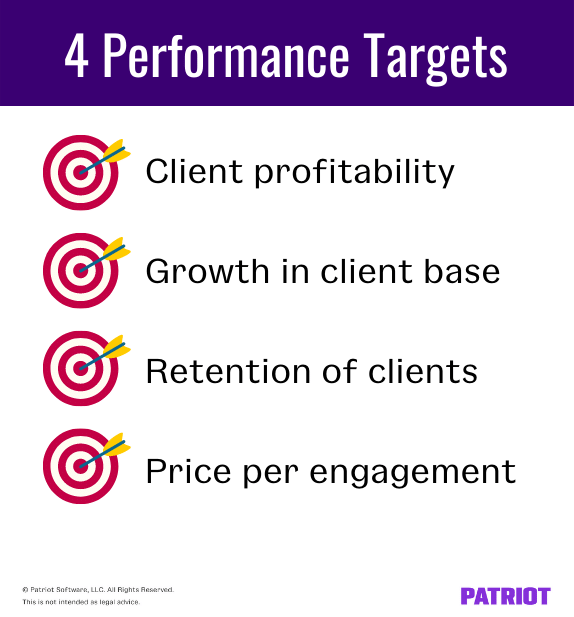As an accountant professional, you want to be the absolute best of the best for your clients. And to do that, you may need to set and track performance targets. But, what are performance targets for accountants, and how do they work? Keep reading for a breakdown of professional goals for accountants and performance target examples.
What are performance targets?
A performance target is a specific goal that you set out to achieve within a specific timeframe (e.g., a year). Many businesses and firms use performance targets to reach certain goals, improve performance and productivity, and keep everyone on track to success.
With performance targets, accounting KPIs (or key performance indicators) come into play. KPIs are performance measurements that evaluate the success of a business and its activities.
Performance targets can vary within your firm. For example, an accountant’s performance targets may include increasing efficiency, while an accounts receivable specialist may focus more on reducing invoice processing time.
How to create a performance target
Again, each firm’s and business’s KPI targets vary. However, the process of setting bookkeeper performance goals is similar from firm to firm. Follow the steps below to get started creating your targets:
- Evaluate your current goals
- Identify what works and what needs improvement
- Set targets and be as specific as possible
- Create a deadline for each goal
- Keep your team in the loop about targets
Your performance targets should be SMART. What does this mean? Goals should be specific, measurable, achievable, realistic, and time-bound. Using this “smart” tactic can help you set solid goals for your firm and stay on track.
Top 4 performance targets to keep in mind
When setting performance targets for your firm, keep in mind that your firm’s goals may be different than another firm’s.
Need some help getting started? Here are four common performance targets you can shoot for.

1. Client profitability
Without your clients, your firm wouldn’t make a profit. And without profits, you wouldn’t be in business. One performance target you should track is client profitability.
Depending on your firm, you may want to track profitability month-over-month, quarterly, or year-over-year.
You can see how profitable your clients are for your firm by adding up the revenue generated by each client and subtracting job-related costs (e.g., accounting software and supplies).
To avoid adding everything together manually, you can use software to track billing and pull reports for totals.
Once you know what your client profitability is, you can determine how to increase it over time. Maybe you need to reevaluate your current pricing. Or, maybe you need to add additional packages or offerings. Then you can set a realistic goal that aligns with your plan (e.g., increase profitability by 10% in 2023).
2. Growth in client base
You can also use targets and goals to track and improve your client growth. Keeping track of this metric can see if your firm is growing or slowing down. Then, you can take the proper steps to boost growth and profitability for your firm.
You may want to track both overall growth and new client growth to see where your firm stands. Take a look at your current growth metrics. Once you see how many clients your firm has brought in for a specific period, you can determine what your goal will be (e.g., increase client base by 30% in X amount of time).
After determining your target, list what you can do to reach said goal. To grow your client base, you can switch up your marketing tactics, ask for referrals, etc.
3. Retention of clients
Again, your clients mean everything to your firm. Without them, your firm can’t thrive. And in order to thrive, you need to retain your clients for the long haul.
One performance target you should track is client retention. Yes, you want to attract new clients. But, it’s also oh-so-important to keep the ones you’ve already got. Not to mention, it can cost five times more to acquire a client than to retain one.
Make it a goal to track your client retention and improve your retention rate with your performance targets. Once you determine your current retention rate, you can set short-term goals, like a referral program, to help you meet the overarching goal of improving your client retention.
4. Price per engagement
Is your firm charging enough? Too little? Too much? Tracking price per engagement can help you determine all of the above.
Average price per engagement can help you with growth planning as your firm expands. As your firm grows, your price per engagement should, too. If it doesn’t, you may need to do some tweaking to your costs to ensure you’re getting paid what you’re worth.
To help track this goal and improve it over time, look at time spent and billing during the period to get an idea of your average price per engagement.
Other performance targets to keep in mind
There are plenty of performance targets for your firm to keep on its radar. Some are big and take more time to achieve, while others are smaller and can be accomplished quickly.
Here are some examples of other goals and targets you can track at your firm:
- Lead conversions
- Employee productivity
- Cross-selling and upselling
- Client services
- Service profitability (i.e., profitability of each service you offer)
The sky’s the limit when it comes to performance targets. You can set whichever goals you’d like. So, do your research, look into your current metrics, see what needs improvement, and get going with your performance targets!
Want to take your accounting firm to the next level? Get discounted pricing on Patriot’s accounting and payroll software for accountants, free co-branding, and more.
This is not intended as legal advice; for more information, please click here.




